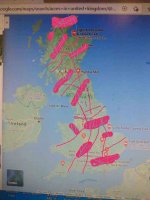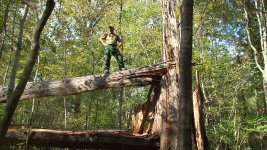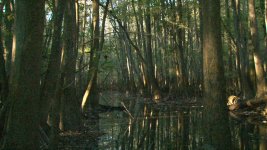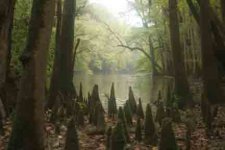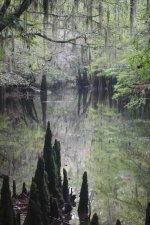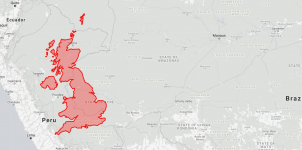View attachment 1367251
How would you find one bird?
How long would it take?
How long would it take you to get an equivocal picture/vid and how ?
How long would it take you to get an unequivocal picture/vid and how ?
Your recon says this about
Campephilus isla which found only here:
Above is a large island the exact size of Great Britain (see map and key) called South Great Britain discovered by the great Englishman naturalist Catesby. It has ~ 7.5 million acres of forest (see pink) surrounded by farmland, small towns and a few small cities. The island is a perfect size correlate to GB but everything else is like Louisiana or N FL, USA. The island is situated 50 miles off the USA from FL to SC (subtropical to temperate zone). There coincidently are 7.5 million acres of forest in the mainland IB Woodpecker habitat,
The human population is one/seventh of the present UK, and is like Louisiana at 90 people/ sq mile but half of them are in 5 small cites, meaning large areas around the forests have only 2 people/sq mile (farms with small patches of forest, few birders). Note for comparison the pop of UK is ~ 660 p/ sq mile.
Half the 7.5 million forest acres are private land, and you should not enter but certainly some minimal trespassing on only the edges occurs. Trespassing any further in will risk arrest or worse and it's difficult anyway since the few gated roads are locked and boat ramps are not open to you and a boat and your parked vehicle will be noticed on the dead end road/ramp area.
The pinkish areas are forests, the blue lines through the forests are large rivers and rivers, some a hundred + miles long, .05 to 1 mile wide. Streams, creeks, sloughs and oxbow lakes number in the thousands and are not visible due to scale. The thin pink forests are .25 to 2 miles wide and C. isla can use them. Line transects are mostly impossible.
There are paved roads almost completely ringing or bordering every forest, two hundred yards from the forest edge, through farm fields and 400 small towns. There are only 3 paved roads cross the lesser width of each large forested area. There are mud and dirt roads every 2 miles, most private, IN seasonal UPLANDS, but there are many 50 sq mile areas with no roads since they are seasonally flooded. The thin strips of forests on the map are along rivers and there is bridge every 20 miles. The outer areas/perimeters of the large forested areas are mainly planted pines for silviculture average height 70 ft and dbh 18 in. The many lower topo areas through the pine forest have nice second growth to late successional riparian forest with cypress, water hickory ,various oaks, maples, willows, tulip, dogwood, sweet gums etc., often some late successional patches of 100 acres. A hundred patches of 1000 acres to several 30,000 contiguous flooded acres of cypress are spaced along the rivers, where the river slope is minimal.
The center of the forest areas are seasonally flooded or flooded and totaling 1,000,000 acres of late successional riparian forest with 90 -130 foot canopy. Of this maybe 70,000 acres is virgin with 130 ft canopy .
Best time to search is fall to early spring when snakes, gators, ticks, spiders, boars, heat and humidity can be tolerable. Spring though summer can be very difficult and unproductive. Best technique it to camp because it can take a half day to 1 day to get to best areas. Otherwise you need to get up at 3AM every day and hike/paddle in for 4 hours in and 4 out every day. Note there are no bars, convenience stores, photo stores, hospitals, showers, in the forest......just forest, forest, creek, swamp, forest, bayou, river, logs, etc. There is no place to charge your cam. batteries and cell phone coverage can be e spotty to non-existent in best IB isla areas.
In those forests are perhaps 20 ?
C. isla left in 3, 4, large pockets and they do not like people and are relatively smart and quiet. No attraction method has worked but sometimes they DK or kent when you are near. They are behaviorally and morphological just like
C principalis. They also suffered heavy hunting pressure just when the population was dropping.
D. pileatus is uncommon to common in the forests. On average you will get 150 a week and get pictures of 1 to 4 if you try, which you should not be doing since its not the target.
How would you find one bird?
How long would it take ?
How long would it take you to get an equivocal picture/vid and how ?
How long would it take you to get an unequivocal picture/vid and how ?
pictures may be posted
View attachment 1367252






